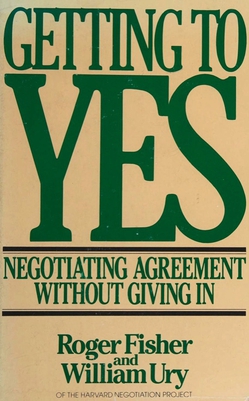Dispute resolution is the process of resolving disputes between parties. The term dispute resolution may also be used interchangeably with conflict resolution, where conflict styles can be used for different scenarios, and is a judicial system which supply a apparatus for resolution of antagonisms between citizens, between citizens and the government, between two state government and between the centre and state governments.
Roger D. Fisher was Samuel Williston Professor of Law emeritus at Harvard Law School and director of the Harvard Negotiation Project.

Conflict resolution is conceptualized as the methods and processes involved in facilitating the peaceful ending of conflict and retribution. Committed group members attempt to resolve group conflicts by actively communicating information about their conflicting motives or ideologies to the rest of the group and by engaging in collective negotiation. Dimensions of resolution typically parallel the dimensions of conflict in the way the conflict is processed. Cognitive resolution is the way disputants understand and view the conflict, with beliefs, perspectives, understandings and attitudes. Emotional resolution is in the way disputants feel about a conflict, the emotional energy. Behavioral resolution is reflective of how the disputants act, their behavior. Ultimately a wide range of methods and procedures for addressing conflict exist, including negotiation, mediation, mediation-arbitration, diplomacy, and creative peacebuilding.

An international environmental agreement or sometimes environmental protocol, is a type of treaty binding in international law, allowing them to reach an environmental goal. In other words, it is "an intergovernmental document intended as legally binding with a primary stated purpose of preventing or managing human impacts on natural resources." An agreement between two nations is known as a bilateral environmental agreement.

The zone of possible agreement (ZOPA), or bargaining range, describes the intellectual zone in sales and negotiations between two parties where an agreement can be met which both parties can agree to. Within this zone, an agreement is possible. Outside the zone no amount of negotiation will yield an agreement.
The Program on Negotiation (PON) is a university consortium dedicated to developing the theory and practice of negotiation and dispute resolution. As a community of scholars and practitioners, PON serves a unique role in the world negotiation community. Founded in 1983 as a special research project at Harvard Law School, PON includes faculty, students, and staff from Harvard University, Massachusetts Institute of Technology and Tufts University.
Conflict resolution is any reduction in the severity of a conflict. It may involve conflict management, in which the parties continue the conflict but adopt less extreme tactics; settlement, in which they reach agreement on enough issues that the conflict stops; or removal of the underlying causes of the conflict. The latter is sometimes called "resolution", in a narrower sense of the term that will not be used in this article. Settlements sometimes end a conflict for good, but when there are deeper issues – such as value clashes among people who must work together, distressed relationships, or mistreated members of one's ethnic group across a border – settlements are often temporary.
Dispute Systems Design (DSD) involves the creation of a set of dispute resolution processes to help an organization, institution, nation-state, or other set of individuals better manage a particular conflict and/or a continuous stream or series of conflicts. For an article about systems for dealing with disputes within organizations see also complaint systems.
Alternative dispute resolution includes dispute resolution processes and techniques that act as a means for disagreeing parties to come to an agreement short of litigation. It is a collective term for the ways that parties can settle disputes, with the help of a third party.
A complaint system is a set of procedures used in organizations to address complaints and resolve disputes. Complaint systems in the US have undergone several innovations especially since about 1970 with the advent of extensive workplace regulation. Notably in many countries, conflict management channels and systems have evolved from a major focus on labor-management relations to a much wider purview that includes unionized workers and also managers, non-union employees, professional staff, students, trainees, vendors, donors, customers, etc.
Leonard J. Marcus is an American social scientist and administrator. He is director of the Program for Health Care Negotiation and Conflict Resolution at the Harvard T.H. Chan School of Public Health at Harvard University, and founding co-director of the National Preparedness Leadership Initiative, a joint program of the Harvard T.H. Chan School of Public Health and the Center for Public Leadership at Harvard's Kennedy School of Government.
Barry C. Dorn, M.D. is Associate Director of the National Preparedness Leadership Initiative (NPLI), a joint program of Harvard T.H. Chan School of Public Health(HSPH) and the Center for Public Leadership at Harvard's John F. Kennedy School of Government and Associate Director of the Program for Health Care Negotiation and Conflict Resolution at HSPH. He is also an Instructor in Public Health Practice at HSPH and Clinical Professor of Orthopedic Surgery at the Tufts University School of Medicine. Additionally, he served on the Faculty of Health Services at Ben-Gurion University of the Negev, Israel from 2010-2013. Formerly, he practiced at Excel Orthopedic Specialists. He retired from medical practice in 2007. Dr. Dorn is among the leaders in the development of the health care negotiation and conflict resolution field.

Getting to Yes: Negotiating Agreement Without Giving In is a best-selling 1981 non-fiction book by Roger Fisher and William L. Ury. Subsequent editions in 1991 and 2011 added Bruce Patton as co-author. All of the authors were members of the Harvard Negotiation Project. The book made appearances for years on the Business Week bestseller list. The book suggests a method called principled negotiation or "negotiation of merits".

William Ury is an American author, academic, anthropologist, and negotiation expert. He co-founded the Harvard Program on Negotiation. Additionally, he helped found the International Negotiation Network with former President Jimmy Carter. Ury is the co-author of Getting to Yes with Roger Fisher, which set out the method of principled negotiation and established the idea of the best alternative to a negotiated agreement (BATNA) within negotiation theory.

Robert Harris Mnookin is an American lawyer, author, and the Samuel Williston Professor of Law at Harvard Law School. He focuses largely on dispute resolution, negotiation, and arbitration and was one of the primary co-arbitrators that resolved a 7-year software rights dispute between IBM and Fujitsu in the 1980s. Mnookin has been the Chair of the Program on Negotiation at Harvard Law School since 1994.

David Lax is currently the Managing Principal of Lax Sebenius, LLC, and a Distinguished Fellow at the Harvard Negotiation Project and a former professor at Harvard Business School.









